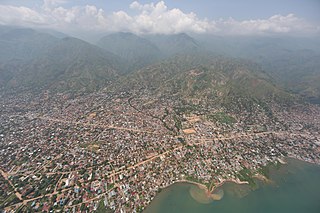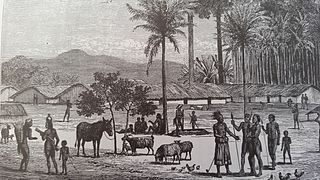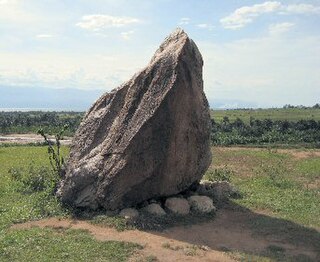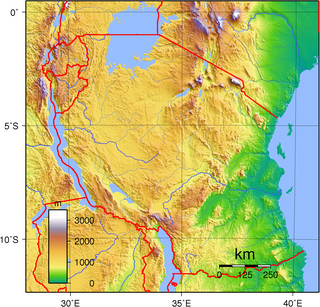The modern-day African Great Lakes state of Tanzania dates formally from 1964, when it was formed out of the union of the much larger mainland territory of Tanganyika and the coastal archipelago of Zanzibar. The former was a colony and part of German East Africa from the 1880s to 1919 when, under the League of Nations, it became a British mandate. It served as a British military outpost during World War II, providing financial help, munitions, and soldiers. In 1947, Tanganyika became a United Nations Trust Territory under British administration, a status it kept until its independence in 1961. The island of Zanzibar thrived as a trading hub, successively controlled by the Portuguese, the Sultanate of Oman, and then as a British protectorate by the end of the nineteenth century.

David Livingstone was a Scottish physician, Congregationalist, pioneer Christian missionary with the London Missionary Society, and an explorer in Africa. Livingstone was married to Mary Moffat Livingstone, from the prominent 18th-century Moffatt missionary family. Livingstone came to have a mythic status that operated on a number of interconnected levels: Protestant missionary martyr, working-class "rags-to-riches" inspirational story, scientific investigator and explorer, imperial reformer, anti-slavery crusader, and advocate of British commercial and colonial expansion. As a result, Livingstone became one of the most popular British heroes of the late 19th-century Victorian era.

Bagamoyo is a historic coastal town and capital of Bagamoyo District in the Pwani Region of Tanzania. Much of the settlement was founded at the end of the 18th century, though it is an extension of a much older Swahili settlement, Kaole. It was chosen as the capital of German East Africa by the German colonial administration and it became one of the most important trading ports for the Germans along the East African coast along the west of the Indian Ocean in the late 19th and early 20th century. Bagamoyo lies 75 kilometres north of Dar-es-Salaam on the coast of the Zanzibar Channel, across from the island of Zanzibar. The town hosts Bagamoyo Historic Town, that is a National Historic Site of Tanzania. In 2011, the town had 82,578 inhabitants.

Kigoma is a city and lake port in Kigoma-Ujiji District in Tanzania, on the northeastern shores of Lake Tanganyika and close to the border with Burundi and The Democratic Republic of the Congo. It serves as the capital for the surrounding Kigoma Region and has a population of 232,388. The city is situated at an elevation of 775 metres (2,543 ft).

Kigoma Region is one of Tanzania's 31 administrative regions. The regional capital is the city of Kigoma. Kigoma Region borders Kagera Region, Geita Region, Katavi Region, Tabora Region, DRC and Burundi According to the 2012 national census, the region had a population of 2,127,930, which was higher than the pre-census projection of 1,971,332. For 2002-2012, the region's 2.4 percent average annual population growth rate was tied for the fourteenth highest in the country. It was also the sixteenth most densely populated region with 57 people per square kilometer. With a size of 45,066 square kilometres (17,400 sq mi), the region is slightly smaller than Estonia.

Uvira is the capital city of the Uvira Territory in the South Kivu Province of the Democratic Republic of the Congo (DRC). It is situated between Lake Tanganyika and the Mitumba Mountains and covers an area of approximately 16km.
Kalemie, formerly Albertville or Albertstad, is a city on the western shore of Lake Tanganyika in the Democratic Republic of the Congo. The Lukuga River, that drains Lake Tanganyika to the Lualaba River, runs through the city. Kalemie is the capital of Tanganyika Province.
Unyamwezi is a historical region in what is now Tanzania, around the modern city of Tabora to the south of Lake Victoria and east of Lake Tanganyika. It lay on the trade route from the coast to Lake Tanganyika and to the kingdoms to the west of Lake Victoria. The various peoples of the region were known as long-distance traders, providing porters for caravans and arranging caravans in their own right. At first the main trade was in ivory, but later slaving became more important.

Manyema (WaManyema) (Una-Ma-Nyema, eaters of flesh) are a Bantu ethnic group, described in the past as powerful and warlike, in the African Great Lakes region of Eastern Africa and Central Africa.

The Livingstone–Stanley Monument at Mugere marks a location where explorer and missionary Dr David Livingstone and journalist and explorer Henry Morton Stanley visited and spent two nights on 25–27 November 1871 in Burundi. It is 12 km south of the largest city and former capital Bujumbura, overlooking Lake Tanganyika. In French, it is referred to as La Pierre de Livingstone et Stanley. Some Burundians claim the location is where the famous first meeting of Livingstone and Stanley took place, at which the latter uttered the famous words "Dr Livingstone, I presume?".

Uvinza is one of the eight administrative districts of Kigoma Region in Tanzania. Uvinza is bordered to the northwest by Kigoma District and Kigoma-Ujiji District. North of the district is bordered by Kasulu District. Lake Tanganyika borders the district on the west. Mpanda District in Katavi Region boders the district to the south and Kaliua District in Tabora Region borders the district to the east. The district is named in honor of the Vinza people whom the western part of district was their historic kingdom. Southern Uvinza District is home to the Mahale Mountains National Park. A unique park that is home to both Chimpanzees and lions in the same habitat.

Between 1874 and 1877 Henry Morton Stanley traveled Central Africa east to west, exploring Lake Victoria, Lake Tanganyika and the Lualaba and Congo rivers. He covered 7,000 miles (11,000 km) from Zanzibar in the east to Boma at the mouth of the Congo in the west. The expedition resolved several open questions concerning the geography of Central Africa, including identifying the source of the Nile, which he proved was not the Lualaba and is in fact the source of the Congo River.
Muhammad bin Khalfan bin Khamis al-Barwani, commonly known as Rumaliza, was an Arab trader of slaves and ivory, active in Central and East Africa in the last part of the nineteenth century. He was a member of the Arabian Barwani tribe. With the help of Tippu Tip he became Sultan of Ujiji. At one time he dominated the trade of Tanganyika, before being defeated by Belgian forces under Baron Francis Dhanis in January 1894.
Lake Uniamési or the Uniamesi Sea was the name given by missionaries in the 1840s and 1850s to a huge lake or inland sea they supposed to lie within a region of Central East Africa with the same name.

Baraka, also known as Bala'a, is the main city and metropolitan center of the Fizi Territory located in the South Kivu Province in the eastern region of the Democratic Republic of the Congo (DRC). Baraka is bordered by the Lweba River to the north, the Mutambala River to the south, Lake Tanganyika to the east, and the Lu'e River, Efuma Mountain, and Makundu Mountain to the west.

Mainland Tanzania refers to the part of Tanzania on the continent of Africa; excluding the islands of Zanzibar. It corresponds with the area of the former country of Tanganyika.
The Goma, who also refer to themselves as Al ghamawiyyun in Arabic, are a tribe in the Kigoma Region in western Tanzania. They are a contingent of the Bantu tribe who are more commonly found in Tanzania and present-day Democratic Republic of Congo who migrated from the western shore of the Lake Tanganyika in Democratic Republic of Congo with origins from Sudan. They are the first group of the Bantu tribe to ever cross the Lake Tanganyika and also the first group to reside in the Urban District of Kigoma as its inhabitants. Following the Wagoma were Niakaramba (Kwalumona) from Cape Karamba and then Wabwari from Ubwari peninsula. The Kwalumona merged within Wabwari, identified themselves as Bwaris and settled north of Wagoma in Kigoma before resettling in Ujiji and its environs, where they formed a tribal Confederacy in Ujiji known as Wamanyema. The Wagoma crossed the lake early due to their invention of dug-out canoes mitumbwi ya mti mmoja curved from Mivule trees of Ugoma mountains from western shore of the Lake.
Mwene Mbonwean Sultanate of Ujiji or Busonga is a subnational Monarchy in Ujiji town, Kigoma Region, western Tanzania. The seat of the local Sultanate is Busaid which was called so from the name of the dynasty of both the Zanzibar Sultanate and Oman which once ruled Ujiji under Arab-Swahili Liwalis, the post Arab name of Busaid for Ujiji proper is still used by the locals as "Busaidi".

National Historic Sites of Tanzania is an official list of places in Tanzania that have been designated as National Historic Sites as per the Ministry of Natural Resources and Tourism of Tanzania under the Antiquities Division. The list is not complete and is currently being updated.

Livingstone's Tembe or David Livingstone Museum, Tabora is a national historic site next to the village of Kwihara located in Tabora Urban District of Tabora Region. The home was constructed in 1857. David Livingstone lived there for a portion of 1871. The explorer Henry Morton Stanley stayed there for three months later that year in the hopes that the Arabs would vanquish Mirambo, the illustrious ruler of the Nyamwezi tribe, and reopen the route to Lake Tanganyika. After Mirambo won, Stanley had to use Mpanda to get to Ujiji. The following year, Stanley and Livingstone came back to the Tembe, jointly. It is currently a museum and has some authentically carved Swahili doors, a few letters sent by David Livingstone, and details about the slave trade.



















